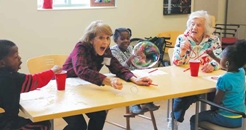 Places where younger and older people thrive together
Places where younger and older people thrive together
From a report by Generations United and The Eisner Foundation
Within the walls of a rather non-descript former community center in a high-poverty neighbourhood of Columbus, Ohio, some magic happens every day when young children and older adults at Champion Intergenerational Enrichment and Education Center get together, often in the multipurpose room that bridges the childcare and older adult areas of the building. Students from The Ohio State University also play a role. At Champion, the young, old and those in-between make genuine connections.
Champion is an intergenerational shared site, an often misunderstood concept that pairs younger generations with older adults in the same physical location, with periodic activities or programs that bring them together.
While far from a household name, shared sites may well be a concept whose time is now. There’s a convergence of opportunity at hand, brought about by a variety of factors including the demand for quality children and youth services, the need for creative older adult programs and limited local and national resources for construction and rehabilitation of facilities. The use of space by multiple generations makes common sense.
Demographics are also fueling innovation. People are living longer and healthier lives. The growing asset of older adults needs to be engaged and shared sites are a smart and innovative way to do that. Additionally a growing body of new research illustrates just how damaging isolation and loneliness can be. The signs point to shared sites as an approach primed to remedy this concern.
Greater awareness of the potential of shared sites can create new environments to confront ageism, break down the barriers of age-segregation and forge long-lasting and life-changing intergenerational bonds. Intergenerational programmes bring purpose to the lives of young and old.
A Harris Poll found plenty of support for programmes that bring diverse age groups together to fend off loneliness, share skills or talents that can help address a child’s/youth’s needs and vice-versa. There was an overwhelming preference for a care setting for loved ones with opportunities for intergenerational contact rather than one with a single age group. There was also a strong belief that senior centres and schools/universities should be creating opportunities for children/youth and older adults to interact.
Other studies found the following benefits:
-
promotion of positive intergenerational relationships
-
improvement of attitudes toward elders and youth
-
better physical and mental health of older participants
-
less isolation and loneliness of older participants
-
involvement in more activities by older participants
-
enhanced learning, social development of children and youth
-
improvement of attitudes towards another group besides young/old
-
greater financial stability of care centres
-
reduction of caregiver/parent stress.
Read the full report here.
Retweet about this article:
From a report by Generations United and The Eisner, 09/04/2019